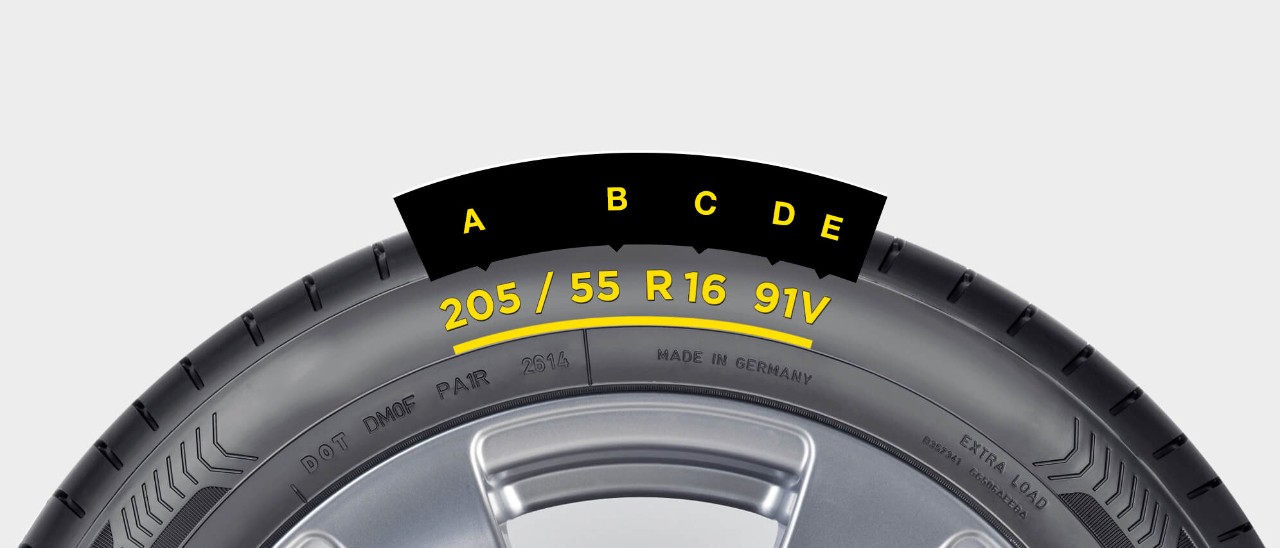Your car tyres are the only thing connecting you to the road, so you need to get the right ones for your car.
This can change depending on your vehicle, time of year and your own driving style.
To browse tyres for your car now, use our tyre finder to find the right tyres for your vehicle. Search by fitment or registration plate.
The first thing you need to get right is the correct tyre size. This information is found on your tyre’s sidewall and is fundamental when browsing for new tyres.
There are five key markings on a tyre’s sidewall that you’ll need to take note of to get the right tyre size for your vehicle.
These markings are listed below, and you can learn more about what they mean exactly in our guide to tyre sidewall markings.
By using your sidewall markings, you can search for a tyre suitable for your car.

A. Tyre Width
B. Aspect Ratio
C. Diameter
D. Load Index
E. Speed Rating
A great place to start looking for new tyres is to find out what the OE (Original Equipment) tyres were for the vehicle. OE tyres are the tyres that were originally fitted to your car. The tyres will have been developed specifically for the car and tested rigorously in order to provide the best performance on road in different weather conditions.
Dunlop is chosen by many car manufacturers to develop OE tyres.
The type of tyre you need can also depend on what season it is during the year.
There are three types of seasonal tyres: Summer, Winter and All-Season tyres.
In the UK we have relatively mild winters, so unlike some European countries, we don’t have any laws stipulating that winter tyres are necessary in the winter months.
However, winter tyres perform better than summer tyres as soon as temperatures drop below 7°c. This means that for improved performance, shorter braking distances and better traction on winter roads, you need a tyre designed to perform in that season.
If you would like the assurance that you’re getting the best possible performance from your tyres, then you should consider investing in both winter and summer tyres. This is especially recommended if you live somewhere with particularly bad winters or are likely to travel through some European countries that stipulate winter tyre use by law.
All season tyres are best if you live somewhere in the country that doesn’t get especially cold or see the worst of the winter weather. You will still get good performance from your tyres in the summer, and when the temperature drops, the tyre has the elasticity to provide good winter performance too.
Additionally, if you simply prefer the convenience of not switching from summer to winter as the seasons change, all season tyres will be the best choice for you.
If you have an SUV or 4x4 vehicle, you need appropriate tyres for that vehicle. SUV tyres are designed to take the additional weight of the vehicle and maintain excellent grip, traction and handling on the road, just as you’d expect in any car. As with car tyres, you’ll need to consider seasonality with SUV tyres too.
4x4 tyres are different again. They are reinforced to be able to handle off road adventures, and have a heavily defined tread pattern which helps to maximise grip on all terrain.
If your car was originally supplied with run flat tyres, it would be best to replace them with another set of run flat tyres. You can identify Dunlop run flat tyres by looking for the words Run On Flat (or the initials DSST) on the tyre’s sidewall. There is no industry standard for this and so other manufacturers may indicate run flat technology slightly differently on their tyres. For example, some Goodyear run flat tyres may contain the initials EMT on the sidewall.
Run Flat tyres allow you to continue driving over a limited distance. The tyres have a reinforced shoulder that will support your car for around 50 miles at a speed of 50mph in the event of a puncture. This will allow you to make it home, or to a dealer or car garage to get the tyre repaired or replaced.
If you would like to fit run flat tyres to normal alloy wheels, you can do so if your car is fitted with a Tyre Pressure Monitoring System (TPMS) in order to alert you in the event of a puncture.
Check Your Tyre Label
You should always check the tyre label when buying new tyres.
The tyre label has information on fuel efficiency, wet grip rating and noise rating.
Fuel Efficiency
Your tyres can have a big impact on the fuel efficiency of your vehicle, accounting for up to 20% of your vehicle’s fuel consumption.
Good quality tyres with low rolling resistance will result in improved fuel efficiency.The tyre label will indicate how fuel efficient your tyres are on a scale of A – G.
Don’t forget, fuel efficiency is also affected by incorrect tyre pressure, so make sure you keep your tyres well maintained.
Noise Rating
Another important consideration is your tyre’s noise levels.
For a quieter ride, you’ll want to invest in noise efficient tyres.
Not only will this provide a quieter ride for yourself, but it’ll also help reduce the noise pollution levels in our cities and towns.
Wet Grip Rating
Wet grip is the tyre’s ability to grip the road in wet conditions, something which is vitally important when driving in the UK.
Ultimately, tyres with a high wet grip rating will stop more quickly on wet roads when full brakes are applied.